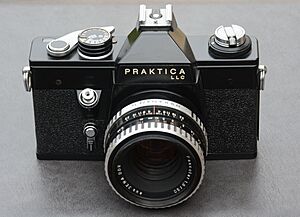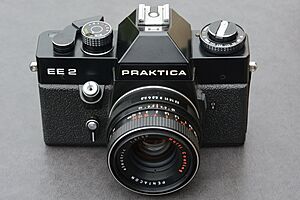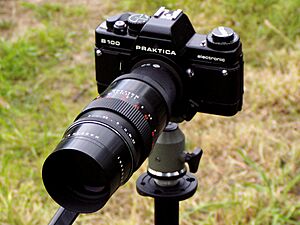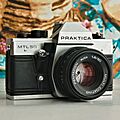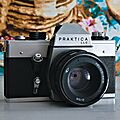Praktica
Praktica was a famous brand of cameras made in Dresden, a city in eastern Germany. The cameras were built by a company called Pentacon from 1949 until 1990. During this time, Germany was divided into two countries, and Dresden was in East Germany.
The company that made Praktica cameras, Pentacon, was formed by combining several older camera companies from Dresden. For a long time, Dresden was like the world's capital for camera making. Pentacon's name comes from two words: Contax, a famous camera brand, and pentagon, the Greek word for a five-sided shape. This is because they invented a special five-sided mirror, called a pentaprism, for their cameras. This mirror lets you see exactly what the lens sees through the viewfinder.
After Germany was reunited in 1990, the Pentacon company was split up and sold. Today, a company called PENTACON GmbH still exists in Dresden and is part of a larger group called the Schneider Group. They continue to make optical equipment, like lenses and even parts for space programs.
In 2001, the company stopped making traditional film cameras. They began to focus on digital cameras, camcorders, binoculars, and other modern optical products. Since 2015, the Praktica brand has been owned by a British company.
Contents
The History of Praktica Cameras
The story of Praktica is part of the long history of camera making in Dresden, Germany. Many important inventions in photography happened there.
Early Innovations
Long before Praktica existed, the companies that would later form Pentacon were already making history.
- 1933: One of the companies, Ihagee, introduced the first SLR camera that used roll film. An SLR camera has a mirror system that lets you see the exact image the lens will capture.
- 1936: The same company created the Kine Exakta, the world's first SLR camera to use 35mm film, which became the standard for many years.
- 1949: A huge breakthrough came with the Contax S camera. It was the first 35mm SLR to have a built-in pentaprism. This special mirror flipped the image, so what you saw in the viewfinder was upright and not reversed, making it much easier to frame your shot. This camera also introduced the M42 screw mount, which let photographers easily swap out different lenses.
The Rise of Praktica
The first camera with the Praktica name appeared in 1949. It used the same M42 lens mount as the Contax S, which meant photographers could use a wide variety of lenses. Over the years, Praktica cameras became known for being reliable and innovative.
Here are some of the key models and their features:
- Praktica FX2 (1956): This was the first 35mm SLR camera with a special mechanism that allowed the lens to automatically open to its widest setting for focusing and then close down to the right setting just before taking the picture.
- Praktica mat (1965): This was the first 35mm SLR in Europe to have "through-the-lens" (TTL) light metering. This meant the camera could measure the light coming directly through the lens to help the photographer choose the right settings for a perfect photo.
- Praktica LLC (1969): This model was the first to use an electric signal to communicate between the lens and the camera body. This made setting the camera for the right exposure even easier and more accurate.
Praktica made many different series of cameras, like the L-series and the B-series, each with new improvements. The B-series, for example, introduced cameras with electronic controls, making them more modern and easier to use.
From Film to Digital
By the early 2000s, photography was changing fast. Digital cameras were becoming more popular than traditional film cameras. In 2001, Praktica stopped making its famous SLR film cameras.
The company shifted its focus to the new digital world. They started producing a range of Praktica digital compact cameras and camcorders. They also continued to make other optical products like binoculars and spotting scopes. Today, the Praktica brand is still used on cameras, lenses, and other electronics, carrying on a long legacy of German engineering.
Images for kids
See also
 In Spanish: Praktica para niños
In Spanish: Praktica para niños
- John H. Noble
- Zeiss Ikon


